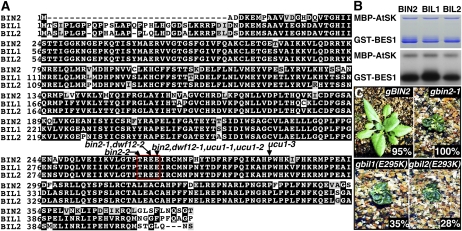Figure 3.
Both BIL1 and BIL2 are capable of blocking BR signaling. A, Sequence alignment of BIN2, BIL1, and BIL2. The sequence alignment was done by the Mcoffee program at http://tcoffee.vital-it.ch/cgi-bin/Tcoffee/tcoffee_cgi/index.cgi, and identical/similar amino acids are shaded with black/gray backgrounds using the BoxShade Server at http://www.ch.embnet.org/software/BOX_form.html. Eight gain-of-function bin2/ucu1/dwf12 mutations are indicated by black arrows, and the conserved TREE motif is boxed in red. B, Both BIL1 and BIL2 are able to phosphorylate BES1 in vitro. The top panel shows Coomassie Brilliant Blue staining of purified MBP-AtSK and GST-BES1 fusion proteins, and the bottom panel shows an autoradiograph of 32P-labeled AtSKs and GST-BES1. C, Both BIL1 and BIL2, when carrying a mutation equivalent to bin2-1, can inhibit BR signaling. Shown clockwise are transgenic plants expressing a wild-type gBIN2 genomic construct, a mutated gbin2-1 transgene carrying the bin2-1 mutation, a genomic gBIL2 transgene with an E293K mutation, and a genomic gBIL1 construct with an E295K mutation. Percentages at bottom right indicate the percentage of T1 transgenic plants (of more than 150 lines) exhibiting each displayed morphology.

